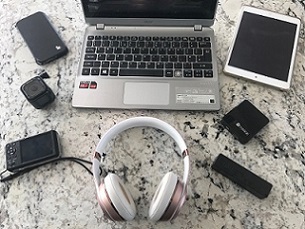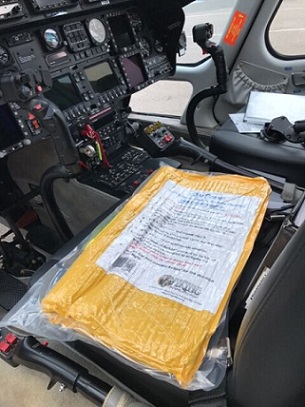 A lithium battery fire is the last thing you want in the confined space of a passenger plane
A lithium battery fire is the last thing you want in the confined space of a passenger plane
 All these everyday electronic devices are powered by lithium batteries
All these everyday electronic devices are powered by lithium batteries
 A pilot holding an award-winning AvSax lithium battery fire containment bag
A pilot holding an award-winning AvSax lithium battery fire containment bag
 An AvSax in its vacuum-packed wrapping
An AvSax in its vacuum-packed wrapping
Millions of people are now starting to jet off on their summer holidays but there is an increasing fire danger on board aircraft which is why you’ll hear a new safety message by the crew.
Passengers are used to hearing about how to deploy lifejackets and oxygen masks during an in-flight emergency but now they’ll stress you must alert them immediately if you lose your mobile phone in your seat or if your electronic device such as a laptop, iPad and even a vape starts to overheat.
This is because all are powered by lithium batteries which can overheat, go into what’s known as thermal runaway, catch fire and even explode.
It’s happening quite often with 446 incidents reported in US airspace from March 2006 to May 2023 – 24 recorded so far this year alone - but figures for UK airspace are not made public.
This is what Ryanair cabin crew now say just before take-off : “If your device or its battery is damaged, hot, produces smoke, is lost or falls into the seat structure then please inform the cabin crew immediately.”
One of the main problems is that if a phone is lost in a seat and the passenger moves the seat to get it then it could crush the phone, sending it into thermal runaway and sparking a fire.
Thermal runaway happens when one cell in a battery overheats it can produce enough heat – up to 900°C (1652°F) – to cause adjacent cells to overheat. This can cause a lithium battery fire to flare repeatedly and, because they burn at such a high temperature, they are very difficult to put out. If this happened in an aircraft hold the sprinkler systems would struggle to cope with a fire of such ferocity as it would quickly spread.
If the device and batteries are in the passenger cabin some planes have lithium thermal fire containment bags such as the award-winning AvSax designed to deal with the emergency quickly and effectively before the aircraft can be filled with heat, fire, and toxic smoke.
AvSax (http://avsax.com/), devised and made by Environmental Defence Systems based in Huddersfield, Yorkshire, are now on more than 16,750 aircraft operated by more than 100 airline companies worldwide. They have been used 33 times to deal with emergencies since the start of 2017 and every time they have been deployed the aircraft has been able to complete its journey safely with no need to divert or make an emergency landing.
AvSax, which won the Queen’s Award for Enterprise for its pioneering innovation, is made from military grade material so can withstand the force of a blast if the device does explode.
The organisation covering flight safety in the UK, the Civil Aviation Authority, says a fire caused by a lithium battery could cause catastrophic damage to an aircraft and even bring it down.
It states: “Poor quality or counterfeit batteries have been the cause of fires on board aircraft. In recent years we’ve seen a growing number of fire incidents involving lithium batteries which have the potential to lead to the loss of an aircraft. All types of batteries must pass stringent tests. Batteries which are not tested such as counterfeit batteries pose a significant risk to flight safety.
“Any fire on board an aircraft, particularly one involving lithium batteries, has the potential to be catastrophic. There have been occasions where incidents involving lithium batteries have occurred in the passenger cabin. Prompt actions of cabin crew and subsequent actions by the flight crew can avoid an inflight fire becoming uncontrollable with potentially disastrous consequences. Therefore, it is important the cabin crew respond quickly.”
Each airline company has its own procedure for dealing with the danger but the one preferred by the CAA is to use specialist battery fire containment bags as they are designed to deal with the problem in seconds. The CAA warns that these so-called burn bags must be able to both cool and contain the device … and AvSax does both.
The CAA adds: “After knocking down flames it could conceivably take just a couple of seconds for a PED to be placed inside a containment bag, allowing it to be moved to a place of safety.
“Passengers could then return to their seats, mitigating potential unrelated safety hazards such as injury in the case of severe turbulence. Equally, the effect on flight crew carrying out their duties following an event on the flight deck would be minimised.”
How do AvSax work?
If an electronic device starts to seriously overheat or emit smoke the cabin crew will pour at least two litres of water into an AvSax. It is imperative to first knock down the flames from the device using an on-board halon fire extinguisher, then transfer the device into AvSax before it reignites. Additional water is then required. The water activates the polymer gel inside the bag causing it to expand around the device. Should the device keep on venting then the AvSax is tough enough to absorb the energy.
The AvSax cools the batteries in the device, reducing the likelihood of the battery igniting but if it does go into thermal runaway with all the battery cells igniting it is all contained within the bag. Tests have shown that AvSax can withstand exploding detonators or battery packs.
Amazingly, the water is absorbed into the internal lining of the bag so the device is dry when it is removed.
To find out more go to http://avsax.com/